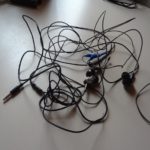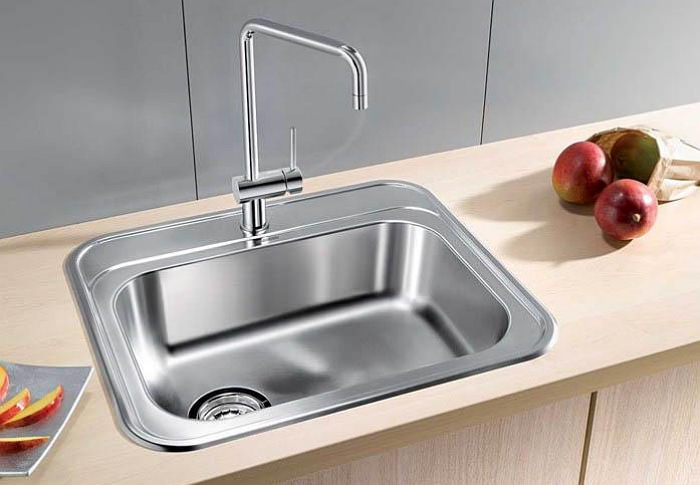How to unclog a sink?
We all periodically encounter such a nuisance as a clogged sink. Water stops flowing into the drain hole naturally, and an unsightly puddle or even a “mini-pool” with waste forms. In order to restore the basic function of the plumbing, wash dishes, vegetables and fruits in it, and also not accidentally flood the neighbors below, the problem must be eliminated as soon as possible. So, how do you break through a sink if it's clogged? What should you do at home to remove the blockage?
The content of the article
Why does the drain pipe in the sink become clogged?
Most often, in kitchen sinks of residential buildings, so-called operational blockage. A person’s daily nutritional requirement is 3-5 times a day. The larger the family, the more you have to cook and wash. In this case, some of the waste ends up in the sewer.
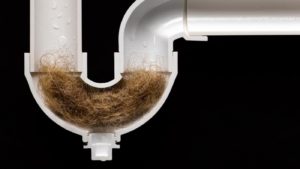 Most of the fat flows down the drain from dirty plates. It is lighter than water and is not completely washed off, partially settling on the walls of the drain pipe. Remains of animal and plant food, dirt and debris, passing through the drain, adhere to the oily coating. Detergents, lime deposits and impurities contained in tap water are added to it. Gradually, the clearance for wastewater decreases to a critical value, which ultimately leads to obstruction.
Most of the fat flows down the drain from dirty plates. It is lighter than water and is not completely washed off, partially settling on the walls of the drain pipe. Remains of animal and plant food, dirt and debris, passing through the drain, adhere to the oily coating. Detergents, lime deposits and impurities contained in tap water are added to it. Gradually, the clearance for wastewater decreases to a critical value, which ultimately leads to obstruction.
More rare types of blockages are technological and mechanical:
- The first occurs as a result of improper installation of plumbing, for example, if there is no slope at the drain or an error in assembling the siphon.
- The second is formed when a fairly large foreign object, such as a rag or sponge, gets into the pipe. Fortunately, almost all modern kitchen sinks are designed to prevent this from happening.
Methods for clearing blockages
If the sink is clogged and you want to deal with the problem on your own, the following will come in handy:
- plumbing tools designed specifically for these purposes;
- liquid and bulk products (mainly chemical).
In any case, at the beginning, try to remove all the garbage you can from the sink so that its entry during your manipulations does not aggravate the already deplorable situation.
Mechanical
In almost any apartment there is plunger - a device consisting of a wooden handle with a thick rubber suction cup at the end. To use it:
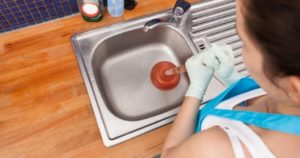 press the rubber valve firmly against the drain hole;
press the rubber valve firmly against the drain hole;- cover the overflow hole with your hand or a rag, if there is one, otherwise you will drive air currents between the drain and the overflow, and the plug will remain in place;
- pour water (5-10 cm) into the sink as hot as possible;
- make several sharp and strong movements down and up according to the principle of the pump. The water in the drain under pressure will rise and fall, tearing off build-up of dirt, freeing the sewer passage from blockage;
- open the hot water, check how it flows. If the situation is a little better than before, but you are not satisfied with the result, repeat the manipulations again.
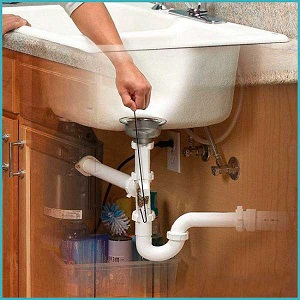 If the plunger doesn't help, you can try to push or pull out the plug using a metal cable, which is often used by professional plumbers. At one end there is a handle, at the other there is a hook, brush or coils, like a spring. It is inserted into the pipe with screwing movements to the required depth in order to “disperse” all the debris. In the absence of a cable, you can use a piece of rigid wire, bending it at the end with pliers.
If the plunger doesn't help, you can try to push or pull out the plug using a metal cable, which is often used by professional plumbers. At one end there is a handle, at the other there is a hook, brush or coils, like a spring. It is inserted into the pipe with screwing movements to the required depth in order to “disperse” all the debris. In the absence of a cable, you can use a piece of rigid wire, bending it at the end with pliers.
Attention! This method is more applicable to metal structures. Plastic ones may crack under excessive mechanical stress.
If all your efforts are in vain, you will have to call plumbers. For an appropriate fee, they will provide you with qualified assistance - they will “cure” your sewer “disease”.
Chemical
If you decide to remove the blockage on your own, but are not ready for physical exercises with a plunger or cable, use household chemicals. For the kitchen sink Alkaline cleaners containing soda and some other additives are suitable.
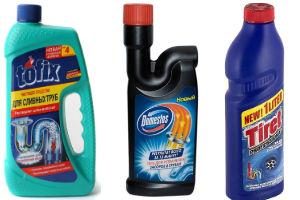 Dry powders or granules have the highest concentration of active substance and the fastest action - from 3 minutes. When they come into contact with water, they are capable of creating a real geyser, often accompanied by the release of a pungent odor. Therefore, their use requires special caution: it is better to work with gloves and a respirator, and thoroughly ventilate the room after use. It is better to send children for a walk, or at least to another room. One bag is designed for one use, a container for several, so it costs more. Popular drugs: domestic Mole, Israeli Unicum Tornado, Mr. Muscle, Bagi Shumanit and Bagi Pothan, British Mr. Muscle and Chirton, Czech RAVAK Turbo Cleaner.
Dry powders or granules have the highest concentration of active substance and the fastest action - from 3 minutes. When they come into contact with water, they are capable of creating a real geyser, often accompanied by the release of a pungent odor. Therefore, their use requires special caution: it is better to work with gloves and a respirator, and thoroughly ventilate the room after use. It is better to send children for a walk, or at least to another room. One bag is designed for one use, a container for several, so it costs more. Popular drugs: domestic Mole, Israeli Unicum Tornado, Mr. Muscle, Bagi Shumanit and Bagi Pothan, British Mr. Muscle and Chirton, Czech RAVAK Turbo Cleaner.
Liquids and gels – softer and safer, although the effect does not occur as quickly as with bulk products. They will have to be poured into the sewer canal and wait at least half an hour. The latter are more economical, but cost an order of magnitude more. According to customer reviews, it is worth paying attention to the Russian products Mole, Sanox “Clean Stock”, Sanfor, Aqualon Deboucher Active and Synergetic, and the English Tiret Turbo.
After using chemicals of any consistency, run strong pressure of hot water down the drain for a few minutes. This will remove any remaining cork and cleaning agent.
Attention! Please read all labels and instructions on the package carefully before use. To avoid damage to your plumbing, try not to exceed the indicated time of action of the drug for a long time.
Homemade
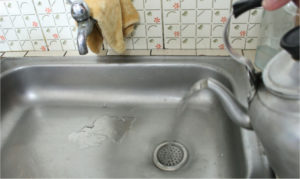 By the simplest means available to any layman, are boiling water, soda and vinegar. They are natural and harmless, do not have an aggressive effect on the respiratory and nervous systems, and are not so dangerous for the skin. But it's better to use them for minor problems with drainage, when the blockage is very small and the flow of water is not very difficult.
By the simplest means available to any layman, are boiling water, soda and vinegar. They are natural and harmless, do not have an aggressive effect on the respiratory and nervous systems, and are not so dangerous for the skin. But it's better to use them for minor problems with drainage, when the blockage is very small and the flow of water is not very difficult.
Boiling water, which can simply be poured into the sink from a kettle, can dissolve oil accumulations and wash them off the walls of the pipe. For plastic, unlike metal, it will be safer to use water whose temperature does not exceed 80˚.
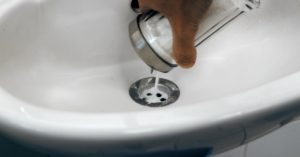 By performing such a water-thermal “attack” daily, you can prevent blockages from occurring.
By performing such a water-thermal “attack” daily, you can prevent blockages from occurring.
If the water doesn't drain quickly enough, pour a few tablespoons of regular tea soda into the drain hole and fill it with table or apple cider vinegar (not essence).After the reaction (bubbles and hissing) is over, wait 30 minutes and rinse everything off with hot, and if possible, boiling water. The plug will dissolve and go down the drain.
By the way! If you mix soda with salt 1:1, the drain will also be disinfected. For severe blockages, you can use baking soda instead of baking soda.
What is dietary supplement powder?
Can be used to dissolve food waste regular washing powder with bioadditives based on active oxygen and bioenzymes, which can not only break down greasy and dirty stains on clothes, but also accumulations in the sewer pipe.
It is better to pour it into the drain hole at night, and rinse thoroughly in the morning under strong water pressure. It won’t cause any harm to metal or plastic, but it will definitely affect fat.
Effective for blockages in the elbow (sump under the sink) environmentally friendly powder mixtures developed for dry closets and other septic tanks. They contain strains of biologically active bacteria in the form of spores, which accelerate decomposition processes and absorb plant and animal residues, reducing their volume by 30-40%. In addition, they neutralize unpleasant odors. To activate the drug, you need to pour it into the sink drain and fill it with plenty of water.
How to clean the siphon?
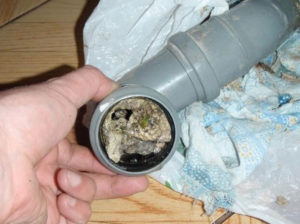 A siphon is an intermediate element connecting the sink to the sewer lines. Usually a flexible hose is stretched from the drain hole to it, and from it there is a corrugation that wedges into the drain pipe. It performs a dual function - blocks sewer stench from entering the kitchen and acts as a septic tankwhere most of the grease and dirt accumulates.When it becomes too clogged and water stops flowing, it should be cleaned.
A siphon is an intermediate element connecting the sink to the sewer lines. Usually a flexible hose is stretched from the drain hole to it, and from it there is a corrugation that wedges into the drain pipe. It performs a dual function - blocks sewer stench from entering the kitchen and acts as a septic tankwhere most of the grease and dirt accumulates.When it becomes too clogged and water stops flowing, it should be cleaned.
To carry out the process:
- prepare an area under the sink: remove all unnecessary items and place a bucket or basin to drain the sewage;
- disassemble the drain system, remove all the crap from the drain elbow (mostly a black slippery mass) and rinse the parts thoroughly. You can pass water through the hose coming from the sink, after directing the opposite end into a bucket;
- after all the parts are sparkling clean, wipe them and reassemble the plumbing lines in the reverse order of disassembly;
- turn on the faucet and check for correct installation. The joints must be dry.
Preventive actions
To prevent the sink from clogging frequently, follow these simple requirements for its use:
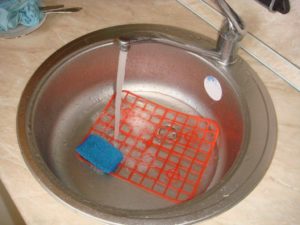 after eating, before washing the dishes, remove all food debris from its walls and bottom;
after eating, before washing the dishes, remove all food debris from its walls and bottom;- cover the drain hole with a filter mesh, clean it daily from accumulated debris and rinse it;
- Once or twice a week, do the above-described manipulations with boiling water (hot water) or soda and vinegar.
To make your life easier and reduce the likelihood of blockages in the kitchen, you can purchase a dishwasher - this will partially help solve the problem. However, in any case, you should not bring your plumbing to a deplorable state, so as not to have to mess around in the dirt and inhale the stench from sewage and chemicals. Compliance with operating recommendations and periodic maintenance will help keep the pipes clean, the smell in the apartment pleasant, and the mood excellent.



